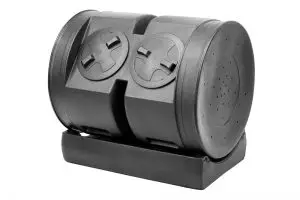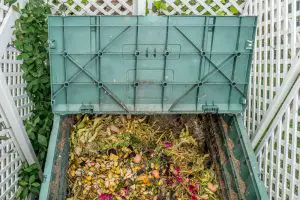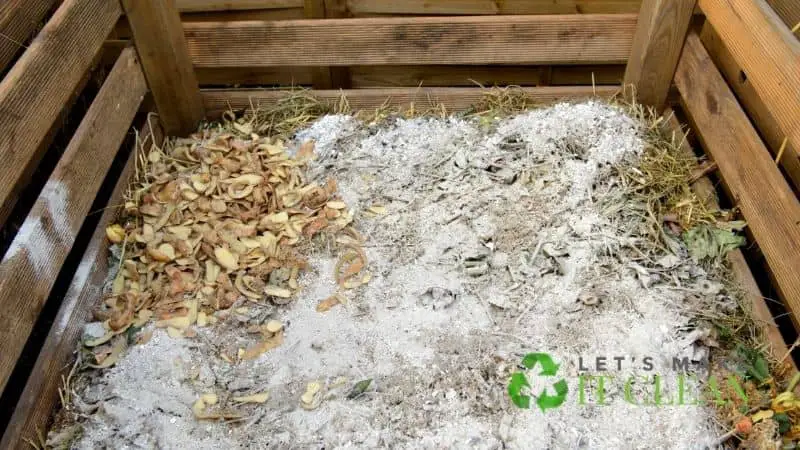Are you missing the enjoyable times with your buddies around your backyard fire pit because of the pungent smell from your composter?
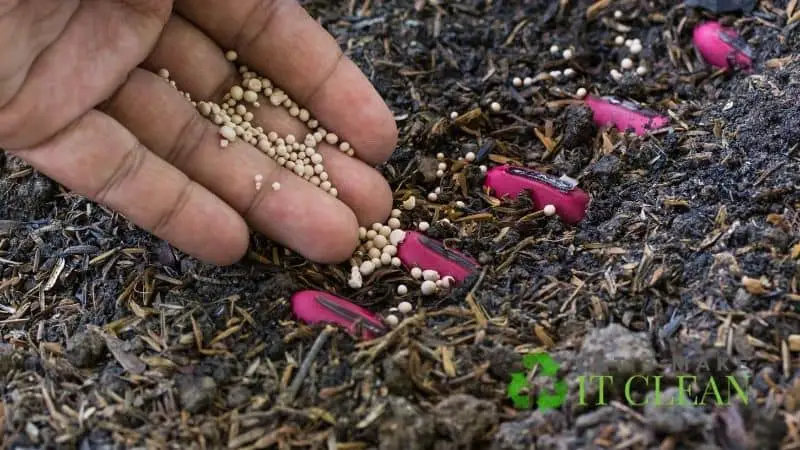
Are you wondering why your garden isn’t flourishing as you hoped even after adding chunks of finished compost? If yes, then there is probably something wrong with your composting procedure.
Quick Navigation
All compost ingredients are groupable into either carbon-rich or nitrogen-dense categories. Ratios aren’t only limited to artificial fertilizers. The only way to get highly nutritious compost is by observing the right nitrogen and carbon proportions.
Organic material contains more carbon than nitrogen. The percentage of carbon and nitrogen brings about the carbon-to-nitrogen ratio (C: N ratio).
Beneficial microbes require the right amount of carbon for the primary building block and an energy source ideal for cell growth. The 1 part nitrogen is crucial for amino acids, nucleic acids, and protein production.
So what is the right number? Typically the ideal C/N ratio for a swift composting process ranges from 25:1 to 30:1. To aid you in getting these proportions right, we’ll tell you which ingredients to put together.
Plus, we’ll show you what dryness or sliminess in your compost implies and how to handle it. Shall we?
Approximated C: N Ratio
Brown or carbon-dense materials contribute to how light and fluffy your compost’s texture becomes. Green or nitrogen-dense materials provide essential substances for the creation of enzymes and co-enzymes.
Are you wondering which compost materials to use? Below are the approximated C: N ratios for several common brown substances.
Approximated C: N Ratio for Brown Substances
Typical Carbon-Dense Substances C: N Ratio
- Dry leaves 60:1
- Newspaper 175:1
- Straw 75:1
- Wood chips 400:1
- Sawdust 325:1
Brown materials contain a high carbon amount. Since carbon decomposition takes a long time, brown materials lengthen the composting process. Carbon is a vital component for development and energy provision. As seen above, most brown substances contain high C: N ratios.
A considerable amount of brown matter promotes enhanced airflow and nourishes the highly beneficial microbes present in compost heaps.
However, too much carbon matter slows down the composting process. So, it would be best if you neutralized them by putting more grass clippings or manure in the compost pile.
Having seen the C: N ratios for brown materials, what is the approximate C: N ratio for some common green substances often added to a compost heap?
Approximated C: N Ratio for Green Material
Common sources of green materials C: N Ratio
- Grass clippings 20:1
- Manure 15:1
- Food scraps 20:1
- Vegetable scraps 25:1
- Seaweed 19:1
Green materials contain high nitrogen amounts. Nitrogen materials break down quickly and provide protein to the essential microbes that participate in the decomposition process.
Nitrogen components are crucial for the cell functionality of enzymes and proteins.
As seen above, most green materials feature low C: N ratios. Too much nitrogen-dense matter often causes a smelly compost pile.
You should neutralize nitrogen-rich materials by adding carbon-dense substances, like dry pine needles, leaves, newspaper, or wood chips.
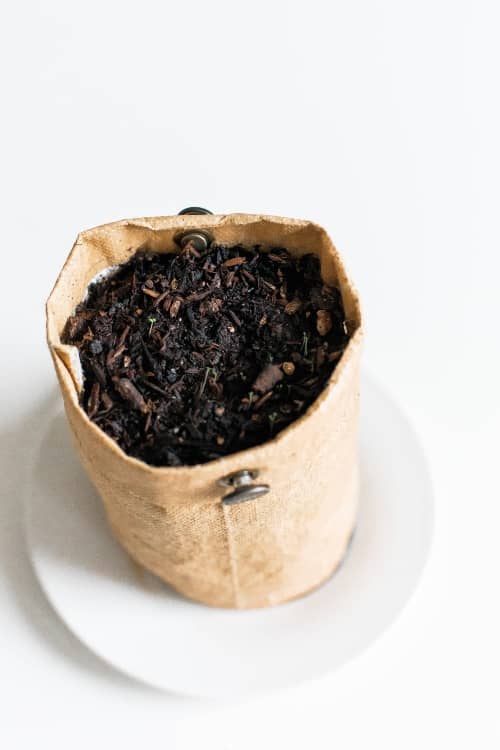
Some home gardeners decide to have excessive amounts of green materials in their compost piles. These ensure there is an ample amount of nitrogen to maintain the warmth of the pile.
Typical Situations Present During Composting
The vital microbes that contribute to compost pile decomposition require 30 parts carbon to 1 part of nitrogen. This C: N ratio offers a balanced nutrient supply for the microbes. Excess nitrogen matter converts to ammonia gas if it doesn’t get used by microbes.
Therefore, it isn’t ideal to have too much green matter in the compost pile. As shown by compost scientists, four main conditions are typical for all composting procedures:
- If there is ample nitrogen supply, less than 35 percent of the carbon in your compost pile gets transformed into nutrient-dense soil.
- Over 65 percent of the carbon in your compost pile gets transformed into carbon dioxide as one of the byproducts of microbial respiration.
- The nutrient-dense soil resulting from the composting process consists of a C: N ratio of 10:1.
- Most fresh plant ingredients contain 40 percent carbon. The differences in the nitrogen composition results in the variation of the C: N ratio.
- The effect of moisture content on the C: N ratio
All microorganisms require moisture. The suitable moisture content for your compost is 40-60 percent. The rate of decomposition slackens once the moisture amount is 35-40 percent.
If moisture level drops under 30 percent, then the decomposition process halts. If this occurs, your pile may start attracting rodents and other small animals.
If your composting mater is excessively dry, adding green materials like food scraps and fruit waste to your compost pile quickly solves the issue. However, don’t overdo when adding these materials. Too many green components in your compost pile heighten the chances of a moisture problem.
If your compost pile is excessively wet, adequate oxygen flow through the moist clumps gets hampered. This causes anaerobic microbes to activate. Consequently, they cause smelly environments as anaerobic microbes are the most significant contributors to foul odor.
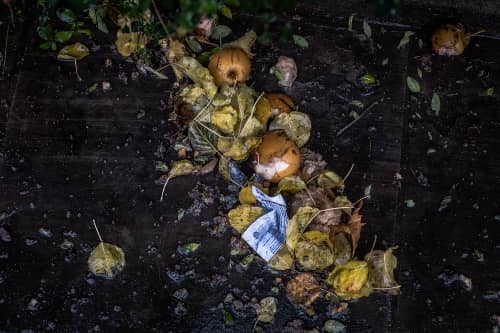
The ideal maximum moisture level ranges from 55 to 60 percent. Anything past this level results in inhibitive compost pile wetness. If this happens, add brown materials to your pile, which then absorb the excessive moisture.
The site you place your composting substances also determines how much water gets to your compost pile. Try to shelter your heap for the attainment of the ideal carbon: nitrogen ratio.
As additional carbon-dense materials get loaded into the composting chamber, you should overhaul your pile to enhance oxygen penetration. Ample oxygen flow promotes aerobic decomposition.
If the C: N ratio of your pile is off and you find difficulties balancing it, empty your tumbler, then refill it with a mixture of fresh carbon matter plus the wet pile ingredients. Adding carbon-rich mater containing a high C: N ratio, like wood chips and sawdust, is crucial in swift moisture reduction.
When the C: N ratio is at the ideal range, it is best to add water, especially during hot summer months. This ensures replenishing the moisture lost in your compost courtesy of evaporation.
In the case of insufficient oxygen, brown materials, such as dry leaves, are an excellent way to enhance better airflow. Should you utilize wood chips, it is better to wet them before putting them into your compost tumbler. Why? Wood chips absorb liquid at a much slower rate than dry leaves.
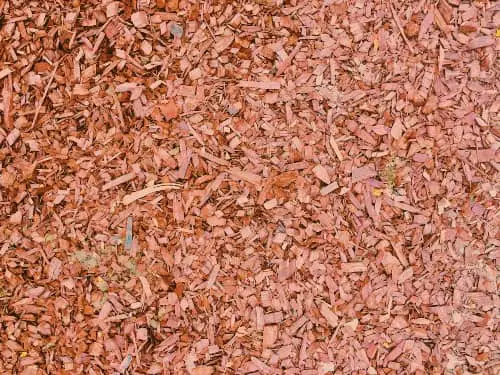
You may mix shredded leaves with wood chips to improve the moisture retention capacity of your compost pile.
Hollow materials, such as toilet paper roll tubes, paper towels, and crumpled paper, can serve as excellent air pockets.
Related article: Best Composting Toilet Reviews
Ideal pH in a Compost
A pH ranging from 5.5 to 8.5 is excellent for compost microorganisms. As fungi and bacteria digest organic matter, they produce organic acids. During the early stages of decomposition, these organic acids accumulate often.
The resultant pH drop encourages fungi growth and the breakdown of cellulose and lignin. Typically, these organic acids further break down as the composting process progresses. Suppose your system shifts to the anaerobic, accumulation of acids may lower the pH level to 4.5. Consequently, the microbial activity gets severely limited. In such cases, ample aeration is usually adequate to return your compost pH to optimal ranges.
The Right Oxygen Amount
Although the atmosphere has 21% oxygen, aerobic microbes survive at concentrations even as low as 5%. Oxygen concentrations over 10% are optimal for facilitating aerobic composting.
Some composts maintain ample oxygen passively by convection and diffusion. Others require active airflow provided using blowers or by mixing and turning your compost ingredients.
Video: Compost Carbon: Nitrogen Ratios Made Simple
Conclusion
In short, the simplest way to know whether you have the right C: N ratio, i.e., the ratio of 30: 1, in your compost pile is by observation and smell.
Your compost shouldn’t have an excessive lousy odor. If so, you have too many greens or nitrogen. A stinky compost pile may also have too many bugs, thus lowering hygiene standards further.
A wet appearance also dictates that your compost has a low C: N ratio. Although your compost should have moisture, it shouldn’t be soggy. Make sure you don’t add too much kitchen waste and plant material while forgetting brown matter.
When your pile appears brown, you either have insufficient water or excessive carbon-rich matter. Add more water and greens to achieve a balance. Remember to consider a small particle size during this process.
Finding the ideal proportions between greens and browns is more of trial and error than mastery of a mathematical ratio. Although commercial composting may have a scientific approach, don’t stress yourself too much with a DIY home composting project.
Looking at and smelling your compost is all you need. If it has an earthy scent, appears dark brown and damp, you are on your way to getting humus-dense compost in no time.





